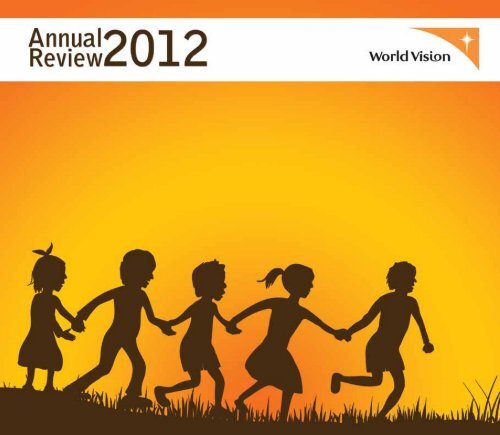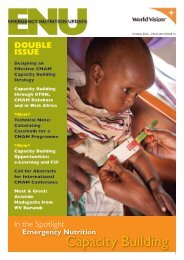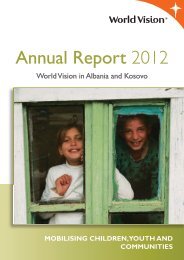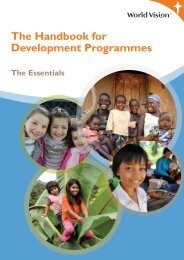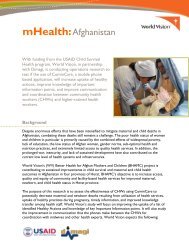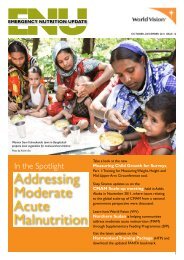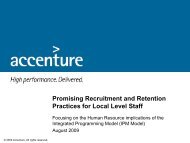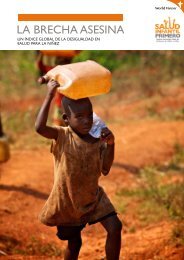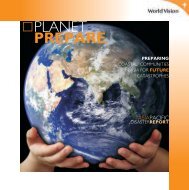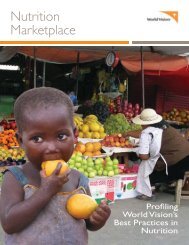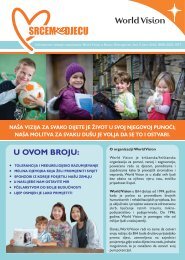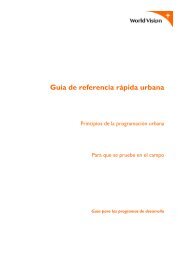Download Publication - World Vision International
Download Publication - World Vision International
Download Publication - World Vision International
Create successful ePaper yourself
Turn your PDF publications into a flip-book with our unique Google optimized e-Paper software.
CONTENTS<br />
Message from the National Director 2<br />
Child Sponsorship 3<br />
Ministries<br />
Transformational Development 5<br />
Humanitarian Emergency Affairs 8<br />
Advocacy 9<br />
Sectors<br />
Maternal Child Health and Nutrition 11<br />
Education 13<br />
Livelihood 15<br />
Water, Sanitation and Hygiene 17<br />
Child Protection 19<br />
Child Health Now 21<br />
Child Well Being 24<br />
Strategy Map 25<br />
FY 2012 Finance Report 26<br />
List of Acronyms 28<br />
Our Core Values<br />
We are Christian<br />
We value people<br />
We are stewards<br />
We are committed to the poor<br />
We are partners<br />
We are responsive<br />
Our vision for every child, life in all its fullness;<br />
Our prayer for every heart, the will to make it so<br />
Annual Review 2012<br />
<strong>World</strong> <strong>Vision</strong> <strong>International</strong> Nepal<br />
3
Who we are<br />
<strong>World</strong> <strong>Vision</strong> is a Christian relief, development and<br />
advocacy organisation dedicated to working with<br />
children, families and communities to overcome<br />
poverty and injustice.<br />
Motivated by our Christian faith, <strong>World</strong> <strong>Vision</strong> is<br />
dedicated to working with the world’s most vulnerable<br />
people. <strong>World</strong> <strong>Vision</strong> serves all people regardless of<br />
religion, race, ethnicity or gender.<br />
Area Development Programme (ADP)<br />
ADP is our primary approach to carry out the transformational<br />
development in the community where we work. ADP is a long<br />
term development programme (10 to 15 years) in which <strong>World</strong><br />
<strong>Vision</strong> works with the poor and its partners in specific, defined,<br />
targeted geographical locations to address micro and macro<br />
poverty issues in the sectors of Maternal Child Health and<br />
Nutrition, Education, Livelihood, Water, Sanitation and Hygiene<br />
(WASH) and Child Protection..<br />
<strong>World</strong> <strong>Vision</strong> started out in Korea in 1950 to meet the<br />
needs of children orphaned by the war in Korea. From<br />
there, the programme expanded to other Asian nations<br />
and gradually spread to nearly a hundred countries.<br />
<strong>World</strong> <strong>Vision</strong> in Nepal<br />
<strong>World</strong> <strong>Vision</strong> first started its development initiatives in Nepal<br />
in 1982 by donating funds to local groups for building hospitals<br />
and providing health care. In response to the 1988 earthquake,<br />
<strong>World</strong> <strong>Vision</strong> supported local non-governmental organisations<br />
in providing assistance to quake victims. Likewise, in 1993, <strong>World</strong><br />
<strong>Vision</strong> helped flood victims through local partners. <strong>World</strong> <strong>Vision</strong><br />
formally started its long-term development work in Nepal after<br />
signing both general and project agreement with the Social Welfare<br />
Council in 2001.<br />
Over the past years, <strong>World</strong> <strong>Vision</strong> <strong>International</strong> Nepal (WVIN) has<br />
funded community development and currently we are operational<br />
in 14 districts namely Bhaktapur, Doti, Jumla, Kathmandu, Kaski,<br />
Kailali, Lamjung, Lalitpur, Morang, Rupandehi, Sunsari, Udayapur,<br />
Achham and Sindhuli.<br />
1
Dear Friends<br />
I am happy to share with you the annual review of the activities,<br />
achievements, and challenges of <strong>World</strong> <strong>Vision</strong> <strong>International</strong> Nepal<br />
(WVIN) during FY 2012.<br />
The past year has been a year of achievement in terms of expanding<br />
Area Development Programme (ADP) coverage. During FY 2012,<br />
WVIN opened three new ADPs. One was in Sindhuli district and<br />
the other two were in Achham and Doti where WVIN already had<br />
two ADPs in both districts. With multiple ADPs in one district,<br />
greater support can be provided to that district in a cost-effective<br />
manner. We are thankful to <strong>World</strong> <strong>Vision</strong> Canada and <strong>World</strong> <strong>Vision</strong><br />
Singapore for funding these new ADPs. We now support a total<br />
of 17 ADPs. By 2014 four ADPs – Kathmandu, Lalitpur, Bhaktapur,<br />
and Kaski – will come to the end of their lifespan. As an ADP<br />
comes to the end of its life, WVIN works with the communities<br />
and government to evaluate the sustainability of programme<br />
impact, and to try to ensure that systems are in place to maintain<br />
the achievement once the ADP closes. Development is one of<br />
WVIN’s core areas of work, along with advocacy and humanitarian<br />
emergency affairs.<br />
A National Office Disaster Management committee was formed<br />
to provide policy support and oversee the disaster management<br />
portfolio at WVIN. WVIN responded to disasters at the community<br />
level and continued to work with government and non-government<br />
organisations to develop District Disaster-Preparedness and<br />
Response Plans, and supported District Disaster Relief Committees<br />
(DDRC) of Morang, Rupandehi, Kaski, and Jumla districts. The Child<br />
Health Now (CHN) campaign was successfully launched during the<br />
past year with events involving WVIN staff, government officials,<br />
partners, and community stakeholders spreading the key message,<br />
Message from<br />
National Director<br />
“Together we can end preventable death”. CHN is <strong>World</strong> <strong>Vision</strong>’s<br />
global campaign to end the preventable death of children under<br />
five. Through the Child Health Now campaign, <strong>World</strong> <strong>Vision</strong> is<br />
calling on the international community to meet its Millennium<br />
Development Goal (MDG) of reducing maternal and child deaths<br />
by 2015 - specifically MDG 4 and 5. Child Health Now in Nepal<br />
aims to contribute to reducing child mortality in disadvantaged<br />
areas of Nepal in line with MDG 4, particularly in the poorest and<br />
most disadvantaged communities.<br />
During the year, over 210,000 children and their family members<br />
participated in <strong>World</strong> <strong>Vision</strong>-supported activities in community<br />
development, relief, and advocacy. These activities focused on the<br />
programme sectors of MCHN, Education, Livelihood, WASH and<br />
Child Protection. WVIN also worked to review its strategy aligning<br />
it with all our systems and processes to ensure achievement of our<br />
Child Well-being objectives.<br />
As the country faces new sets of challenges with the second<br />
Constituent Assembly elections in the offing, WVIN strives to ensure<br />
children are healthy, educated for life, experience the love of God and<br />
their neighbours, and are cared for, protected and can participate.<br />
Lastly, I am grateful to all staff, partners and donors who have<br />
contributed towards the work of WVIN during the past year and<br />
look forward to another year of collaboration.<br />
Sincerely,<br />
Michael Frank<br />
National Director<br />
Annual Review 2012<br />
2
Child Sponsorship<br />
Child sponsorship in <strong>World</strong> <strong>Vision</strong> is an effective and fulfilling<br />
way to help give a child from a poor community the chance of<br />
a brighter future. The goal of sponsorship is to improve the wellbeing<br />
of children. In order to thrive, children need to grow up in<br />
an environment that provides the essentials that they need for<br />
today and hope and opportunities for tomorrow. We believe that<br />
children need good health and to be cared for and protected. They<br />
need to be educated for life, be welcome to participate in decisions<br />
that affect their lives and experience the love of God and of their<br />
neighbours. Sponsors’ contributions fund vital development work<br />
in a sponsored child’s community and makes a real contribution<br />
to the well-being of children. <strong>World</strong> <strong>Vision</strong> works with community<br />
groups and the children themselves to plan and carry out changes<br />
so that more children will gain opportunities to fulfil their<br />
potential in life. Sponsors witness these changes through progress<br />
reports from the community and personal communication with<br />
their sponsored children. Sponsors can encourage the child they<br />
sponsor by writing or even visiting their sponsored child and their<br />
family. <strong>World</strong> <strong>Vision</strong>’s project activities in communities benefit not<br />
just sponsored children but all children and their families.<br />
In FY 2012, 1,500 children from Udayapur East ADP and 1,000<br />
children from Jumla ADP were registered for child sponsorship.<br />
By the end of FY 2012, the number of sponsored children was<br />
19, 750 from 12 districts namely Kathmandu, Lalitpur, Rupandehi,<br />
Lamjung, Kailali, Bhaktapur, Kaski, Sunsari, Morang, Jumla, Doti and<br />
Udayapur. In FY 2012, two ADPs i.e. Udayapur West and Kailali East<br />
also started the Sponsorship Project. Through Annual Progress<br />
Reports (APR) and sending season’s greetings these children can<br />
communicate with their supporters about the change and impact on<br />
themselves and the communities where they live. To better connect<br />
children with their supporters, WVIN took part in sponsorship 2.0<br />
initiatives, a global initiative under child sponsorship operation.<br />
In FY 2012, WVIN was also a part of the Sponsorship Tracking<br />
Enhancement Programme (STEP), a reporting tool which was launched<br />
globally by <strong>World</strong> <strong>Vision</strong>. By December FY 2012 information on all<br />
registered children was published on Support Office websites. Quick<br />
STEP, a new way of uploading data on registered children, started in<br />
three new ADPs (Morang, Kailali West, and Sunsari). National Office<br />
Child Sponsorship generated a STEP report, such as child well-being<br />
summary, presence and participation and corresponding reports,<br />
and shared them among National Office departments to ensure<br />
registered children’s participation in project activities. APR cards<br />
were designed according to the type of ADP concerned. Sponsorship<br />
Basic Training, which links the child sponsorship programme with<br />
child well-being and helps transform supporters, was held in three<br />
different regions, Central, Eastern and Western.<br />
3
Annual Review 2012<br />
Samjhana Sardar, 9, studies in the third grade and loves to go to school. She<br />
lives in a remote village in Bhaudaha Village Development Committee in<br />
Morang, an eastern district of Nepal. She is a <strong>World</strong> <strong>Vision</strong>-sponsored child<br />
whose life has been transformed after receiving a gift from her sponsor.<br />
Samjhana’s sponsor sent her a gift few years ago, a goat. Samjhana’s family<br />
was able to build their own house after working hard to rear the goat, sell<br />
the kids and buy other farm animals. Today, they not only rear goats but<br />
also pigs and a cow in their own small backyard.<br />
4
Transformational<br />
Development<br />
Development is one of WVIN’s core ministries along with<br />
Advocacy and Humanitarian Emergency Affairs. <strong>World</strong> <strong>Vision</strong> uses<br />
the ‘Area Development Programme’ or ‘ADP’, as its core approach<br />
to development. An ADP covers a defined geographical area with a<br />
population of between 20,000 and 50,000 people and according to<br />
WVIN’s strategy and assessment of the needs of the area, features<br />
three to five projects. Key sectors are Maternal Child Health/<br />
Nutrition, Education, Livelihood, and Child Protection and hence<br />
these are usually the core projects. ADPs funded by sponsorship<br />
will also have a Sponsorship Management Project. Depending on<br />
the local needs, Water, Sanitation and Hygiene, or Emergency<br />
Preparedness may be additional projects. In FY 2012 WVIN had 17<br />
ADPs located in 12 districts.<br />
For FY 2012 WVIN’s key initiatives in<br />
development included:<br />
• Refining its approach to development, using <strong>World</strong> <strong>Vision</strong>’s new<br />
Development Programme Approach<br />
• Opening three new ADPs<br />
• Measuring Change<br />
• Preparing four ADPs for closure as they come to the end of<br />
their lifespan in 2013<br />
Refining development approach<br />
From 2007 to 2009, <strong>World</strong> <strong>Vision</strong> (WV) worked globally on refining<br />
its development approach, and looking at lessons learnt in the<br />
way WV does development. This led to the publication of WV’s<br />
Development Programme Approach (DPA), which sets out some<br />
of the basic principles for success in development. Following the<br />
5
piloting of new approaches, WVIN began to align more of its ADPs to<br />
these global principles. By the end of FY12, five ADPs were applying<br />
this new approach to their new designs.The DPA refines WVIN’s focus<br />
in a number of ways. WV sees that effective development is as a result<br />
of relationships – people and systems change based on relationships,<br />
not simply technical knowledge. WVIN therefore sees its core<br />
contribution to development as being one of relationships. WVIN staff<br />
live in the communities where it works, building effective relationships<br />
with community members, understanding the local context, identifying<br />
real issues and real capacities, and encouraging community members<br />
to become active in improving their own situations.<br />
Partnering<br />
Following its efforts at improving its understanding of partnerships,<br />
WVIN has recognised that there are different types of partners. In<br />
an ADP, WVIN works with:<br />
• Community Partners – existing groups such as mothers groups,<br />
water users’ groups, school management committees, and youth<br />
groups that are based in the community. WV works to engage<br />
with these groups to enable them to identify and implement<br />
activities to develop their own communities. The building of<br />
capacity in community groups helps to ensure the sustainability of<br />
impact and activities regardless of WV’s presence.<br />
• Government Partners – local government bodies such as village<br />
and district authorities, branches of the departments of education,<br />
health etc., schools and health posts provide valuable services to<br />
communities and have a mandate to work there.<br />
• NGO Partners – WV works with local NGOs to provide<br />
valuable technical support to communities, helping to improve<br />
knowledge, skills and understanding.<br />
The nature of WV’s relationship varies with each type of partner,<br />
but the key to a successful programme is to have all four –<br />
community, government, NGOs, and WVIN – working together in<br />
a partnership.<br />
Accountability<br />
In addition, the DPA calls for increasing accountability, and looks<br />
at how WV provides accountability to communities, government,<br />
NGOs and donors. In this regard WVIN began piloting a community<br />
feedback mechanism in one ADP, with the hope that it might be<br />
expanded to others.<br />
Using good practice in each sector<br />
Globally WV has looked to see what the best practice is for<br />
programming in each sector i.e. in health and education. As a result<br />
project models have been developed using best practice. WVIN<br />
has taken a selection of these models, contextualised them and<br />
is considering incorporating them in all its new programming.<br />
During FY12, WVIN started carrying out child protection<br />
assessments to help communities and staff understand child<br />
protection issues and identify how to improve local systems<br />
so as to ensure child protection is both implemented in the<br />
interests of the child.<br />
Empowerment approach<br />
One important aspect of the DPA approach is to see<br />
communities and stakeholders as key owners and<br />
implementers of their own development. One approach that<br />
WVIN started in FY 2012 is called Citizen Voice and Action<br />
(CVA). CVA is one form of local level advocacy that transforms<br />
the dialogue between communities and government so as to<br />
improve services like health and education that affect the lives<br />
of children and their families. This empowerment approach<br />
also enabled WVIN to link the community-led approaches to<br />
improve services, with engagement at the national level with<br />
the Child Health Now Campaign.<br />
Expanding ADP coverage<br />
During FY 2012, WVIN opened three new ADPs. One was in<br />
Sindhuli District and the other two were in Achham and Doti<br />
Annual Review 2012<br />
6
where WVIN already had ADPs in both districts. With multiple<br />
ADPs in one district, greater support is provided to that district<br />
so WVIN now prioritises the opening of a second ADP in one district.<br />
Measuring Change<br />
In order to see whether our programming is making the best<br />
impact on the well-being of children, it is important for WV to<br />
measure change over time. To do this, we start by doing a baseline<br />
survey so as to measure the situation at the beginning of a project.<br />
Then the same indicators will be measured on a regular basis so<br />
we can see whether there is progress. During FY 2012, six ADPs<br />
carried out baseline surveys. Key data from ADP and project<br />
baseline surveys were further analysed in the light of the country<br />
context and shared with the government’s Central Programme<br />
Advisory Committee.<br />
Baseline surveys were also done for two projects being carried<br />
out across multiple ADPs: the Child Health Now Project and a<br />
Child Protection Project. These surveys included research which<br />
provided information on how WVIN can influence enforcing good<br />
policies on child protection and child health and maximise its<br />
resources for the benefit of vulnerable children. One ADP (Kailali<br />
West) carried out a household survey as a way of evaluating the<br />
programme after four years. Some positive changes were observed.<br />
e.g. an increase in access to drinking water, in the trend to safe<br />
deliveries, and in food security.<br />
Preparing for ADP closure<br />
In FY 2013 four ADPs – Kathmandu, Lalitpur, Bhaktapur, and Kaski<br />
– will come to the end of their lifespan. Planning continued during<br />
FY 2012 in order to prepare for this. As an ADP comes to the end<br />
of its life, WVIN works with the communities and government to<br />
assess the sustainability of programme impact, and to try to ensure<br />
that systems are in place to maintain that once the ADP closes.<br />
7
HEA is one of the three ministries of WVIN which seeks to<br />
ensure that children and communities can survive disasters<br />
and that the organisation is able to respond to emergencies.<br />
The implementation of those goals takes two forms. One is<br />
the integration of Disaster Risk Reduction (DRR) into Area<br />
Development Programmes (ADPs); the other is preparing the<br />
organisation to respond effectively to emergencies. WVIN has<br />
a strategy of integrating DRR into all ADPs and efforts have<br />
been made to integrate DRR into priority sectors. So far, one<br />
of the ADPs has integrated DRR into the Learning through<br />
Evaluation with Accountability and Planning (LEAP) process, and<br />
other ADPs are in the process of intregrating DRR into their<br />
work. A framework for integrating DRR into education has been<br />
developed and all education projects designed by WVIN have<br />
included DRR.<br />
WVIN has experience of responding to small-scale, short-term<br />
emergencies in ADPs, emergencies such as flooding and landslides,<br />
which occur frequently in Nepal. At national level, WVIN has the<br />
National Emergency-Preparedness and Relief Fund (NEPRF)<br />
which is used for disaster preparedness and initial phase of<br />
response. This amount has been sufficient for the responses that<br />
WVIN has made over the past few years. For FY 2012, $232,837<br />
was allocated to NEPRF.<br />
Humanitarian Emergency Affairs<br />
In FY 2012, a National Office Disaster Management committee<br />
was formed to provide policy support and oversee the disaster<br />
management portfolio at WVIN. Key national office staff including<br />
sector specialists, DME team and some ADP staff were trained<br />
in DRR. In Udayapur West ADP the DRR integration toolkit was<br />
used to ensure DRR integration into project designs. Community-<br />
Owned Vulnerability and Capacity Assessments were carried out<br />
in the communities and issues pertaining to disasters identified by<br />
the communities are now addressed in ADP project designs. The<br />
checklists developed by the DME team for conducting FGD (Focus<br />
Group Discussion) during community consultations also include<br />
risk-related questionnaires.<br />
In FY 2012, WVIN continued to work with government and<br />
non-government organisations to develop District Disaster-<br />
Preparedness and Response Plans, and continued to support 4<br />
District Disaster Relief Committees (DDRC) of Morang, Rupandehi,<br />
Kaski, and Jumla districts. WVIN also responded to the diarrhoea<br />
outbreak in Doti in July-August 2012. 14,603 people from 8 VDCs<br />
were helped with awareness rising activities, soaps, water guard/<br />
aqua tab, Oral Rehydration Solutions. Additionally, across all ADPs,<br />
15,156 people directly benefitted from WVIN’s HEA work in DRR<br />
and emergency relief.people directly benefitted from WVIN’s HEA<br />
work in DRR and relief.<br />
Annual Review 2012<br />
8
Advocacy<br />
WVIN has identified advocacy as one of its core ministries, alongside<br />
transformational development and humanitarian emergency affairs.<br />
WVIN’s advocacy focuses on influencing government policy and<br />
practice to provide greater benefits and services to vulnerable<br />
children and their families. WVIN has identified increased access<br />
to government services for children and communities, promoting<br />
child-friendly local governance, and supporting the Child Health<br />
Now campaign as key areas.<br />
Child Friendly Local Governance (CFLG)<br />
In FY 2012, WVIN’s advocacy continued towards the endorsement<br />
of the National Framework on Child Friendly Local Governance<br />
(CFLG) and its operational guidelines by the Nepal Government<br />
Cabinet. CFLG means a governance system that institutionalises<br />
child rights such as survival; development; protection; and<br />
meaningful participation in the policy, structure, system and<br />
working procedures of local bodies. Following that endorsement,<br />
WVIN and UNICEF agreed on a partnership that aims to<br />
contribute to achieving the objectives of CFLG implementation<br />
at two levels: National and sub-national level. In 2012, orientation<br />
and training in CFLG was held for district-level stakeholders,<br />
including the Association of the District Development Committee;<br />
Nepal and sectoral Ministries, Ministry of Federal Affairs and<br />
Local Development (MoFALD); municipalities, the Municipality<br />
Association of Nepal (MuAN); implementing agencies, government<br />
officers. Other activities conducted were: support and guidance for<br />
the development of user-friendly material for CFLG for community<br />
and frontline workers, software for VDC profile software, and<br />
child-friendly monitoring tool.<br />
Coalitions and networks<br />
In FY 2012, WVIN advocated for children’s rights as a member<br />
of National Coalition for Children as Zones of Peace and Child<br />
Protection (CZOPP). Established in 2003, CZOPP is a national<br />
coalition/network of organisations working in the field of child<br />
rights working collectively to coordinate and integrate advocacy<br />
for the protection and promotion of the rights of children.<br />
Achievements of this network in FY 2012, were meetings with<br />
different stakeholders to ensure children’s rights and their input<br />
into the constitution-making process, meetings on Child Rights Bill<br />
with organisations, key stakeholders and parliamentarians working<br />
exclusively for the promotion of child rights, the promotion of the<br />
Schools as Zones of Peace (SZOP) campaign in co-ordination with<br />
the Department of Education (DOE), and ensuring the coordination<br />
and support among child rights organisation for the Convention on<br />
the Rights of the Child (CRC) monitoring and reporting.<br />
In FY 2012, WVIN also promoted child participation as a member<br />
and partner of the Consortium of Organisations working for<br />
Children’s Participation, a loose national network of organisations<br />
working for the promotion of children’s participation at all levels,<br />
from family to state. Currently, there are 61 member organisations<br />
from 29 different districts representing all five development<br />
regions. In FY 2012, a major achievement of this network, was<br />
the endorsement of the National Policy for Children (Balbalika<br />
Sambandhi Rashtriya Neeti) by Cabinet on 16 April 2012. This<br />
policy is the culmination of four policies concerning Children of<br />
Nepal-Child Survival, Child Development, Child Protection, and<br />
Child Participation. Follow up in the past year on the Child Club<br />
9
Strategic Review also led to the development of a common vision<br />
for child clubs to support the child club movement in Nepal.<br />
Partnership with Government<br />
In FY 2012, and in collaboration with United Nations’ agencies and<br />
international non-governmental organisations WVIN continued to<br />
support the Ministry of Women, Children and Social Welfare. The<br />
partnership aims to strengthen the child protection system, building<br />
mechanisms and structure both at national and district level. In this<br />
regard, at national level, the Central Child Welfare Board (CCWB)<br />
was supported to review and strengthen its structure so as to<br />
function more effectively as a national focal point for its work of<br />
ensuring the rights of children, as well as its launch of the National<br />
Child Protection System and National Child Policy.<br />
Annual Review 2012<br />
13
Maternal Child Health<br />
and Nutrition<br />
Beneficiaries<br />
27,736 mothers and children<br />
Maternal Child Health and Nutrition (MCHN) is one of the key<br />
sectors in WVIN. In the areas (ADPs) that WVIN works in, it seeks<br />
to improve the health of pregnant and lactating women, the health<br />
and nutrition of children under five, reduce malnutrition in under<br />
fives, and increase the quality of household-level management of<br />
childhood illnesses, particularly diarrhoea and pneumonia.<br />
In FY 2012, WVIN implemented maternal child health and nutrition<br />
activities in 6 of its ADPs, in Sunsari, Lamjung, Jumla, Butwal,<br />
Udayapur, Doti districts. In Kathmandu, Lalitpur, and Bhaktapur<br />
ADPs, maternal child health and nutrition activities were carried<br />
out through the ECCD project. Kailali East, Doti East and Udayapur<br />
West ADPs also designed a MCHN project.<br />
In FY 2012, the MCHN project trained and mobilised Female<br />
Community Health Volunteer (FCHV) and mothers’ groups to<br />
provide better health services and disseminate awareness regarding<br />
safe motherhood in wards and VDCs of the areas ADPs work in.<br />
Sessions for pregnant and lactating women and their families to raise<br />
awareness of their special needs during and after pregnancy, the<br />
provision of equipment for local health institutions, the promotion of<br />
outreach clinics have all helped improve maternal and child healthcare<br />
practices at the household and institutional level. With various<br />
awareness raising activities, the trend for pregnant and lactating<br />
mothers to ask health care services for ANC, PNC, TT, Albendazole,<br />
and iron tablets, along with institutional deliveries, has increased.<br />
The MCHN project has also helped to make mothers’ groups more<br />
active. These groups help women share information on different<br />
health issues with each other, issues such as the importance of ANC<br />
and PNC, safe delivery, consumption of nutritious food, rest and<br />
hygiene required during antenatal and postnatal period, infant and<br />
neonatal care, immunisation, breast feeding, and complementary<br />
feeding. The Project has helped strengthen Primary Health Care<br />
– Out Reach Clinics (PHC-ORC). Many of those not functioning<br />
previously, are now active and providing services. Training in homebased<br />
management on diarrhoea and pneumonia, the prevention of<br />
childhood malnutrition, monthly growth monitoring, door-to-door<br />
visits, and the preparation of sarbottam pitho (super flour) and<br />
poshilo jaulo (nutritious rice) were all given. Increased awareness of<br />
the importance of growth monitoring have increased the number<br />
of children visiting growth monitoring units. Positive Deviance<br />
(PD)–Hearth sessions conducted at the community level have<br />
helped improve the nutritional status of children under 5 identified<br />
as malnourished.<br />
In FY 2012, FCHVs, mothers’ groups, care givers, and traditional<br />
healers were all provided with training on the prevention of<br />
childhood diseases at the household level. Hygiene and sanitation<br />
were promoted to reduce childhood illness. Health Facility Operation<br />
and Management Committees (HF-OMC) were strengthened to<br />
provide quality health services to village people. HF-OMC members<br />
received training and were involved in review meetings to reflect on<br />
the existing services provided by the local health facility. ADPs also<br />
organised events at the district level, events such as Breastfeeding<br />
Week, and <strong>World</strong> Health Day, as well as engaging with DPHO and<br />
holding campaigns in the districts they work in.<br />
11
Annual Review 2012<br />
Mothers learn to raise healthy children<br />
Bimala Pariyar (left) is a mother of four children who has been<br />
working as a Positive Deviance (PD) Hearth volunteer mother for<br />
more than two years now in Jumla district. She has been trained<br />
to conduct classes on good nutrition, health and hygiene for young<br />
children in the community with the support of WVIN- Jumla ADP.<br />
Since she received PD Hearth training, she has been conducting<br />
early morning classes for mothers with malnourished children in her<br />
community. Her classes focus on ways to prepare nutritious food<br />
with locally available resources, keeping children healthy and tracking<br />
their development. The classes are conducted in one of the homes of<br />
malnourished children and participants contribute locally produced<br />
resources like maize, beans, vegetables and rice for demonstration<br />
classes. After the demonstration comes to an end, children are<br />
provided the cooked nutritious meal. Since this continues for two<br />
weeks, many malnourished children get an opportunity to eat healthy<br />
food which results in weight gain and better health.<br />
12
Education<br />
Beneficiaries<br />
68,349 children and parents<br />
Education is one of the key sectors in WVIN. In the areas (ADPs)<br />
that WVIN works in, it seeks to improve the equal access to<br />
quality education for children. Education projects in ADPs<br />
advocate increasing the enrolment and improving the quality of<br />
education with child-friendly teaching, better facilities in primary<br />
and secondary schools, and better school management. The<br />
ECCD projects help Early Childhood Education and Development<br />
(ECED) centres which work for the emotional, mental, social, and<br />
physical development of children.<br />
In FY 2012, WVIN implemented education programmes in ten of<br />
its ADPs in Bhaktapur, Jumla, Kathmandu, Kaski, Kailali, Lamjung,<br />
Lalitpur, Morang, Rupandehi and Sunsari districts.<br />
In FY 2012, capacity-building and training activities were held by<br />
ADPs for SMC, PTA, teachers, and for child clubs. ADPs helped<br />
renovate and build classrooms(with standards for earthquake<br />
resistance), as well as built libraries, drinking water facilities,<br />
playgrounds, child-friendly toilets, and girl-friendly sanitation rooms.<br />
ADPs have also provided teaching learning materials and aids to<br />
schools in programme areas. ECED centres were established and<br />
ECED centre management committees were strengthened. The<br />
hand-over of ECED centres to communities in ADPs that are<br />
phasing out in FY 2013, was also done successfully.<br />
In FY 2012, two new ADPs (Udayapur West and Kailali East)<br />
completed their education project design. The Basic Education<br />
Improvement Plan (BEIP), a WV Global Project model, was<br />
introduced, and the model explained to ADP and partner<br />
organisation staff members. WVIN was selected as one of the<br />
first cohort national offices to implement an education project, a<br />
project entitled “Strengthening Education Capacity.”<br />
The review of WVIN Education’s secondary strategy was carried<br />
out in FY 2012. It resulted in including non-formal education as<br />
one of the key elements. To ensure more technical support and<br />
better implementation of projects, area technical staff were also<br />
placed in the district programmes.<br />
13
Annual Review 2012<br />
ECED making children’s future brighter<br />
“I love to come to play and sing songs at school and I love to play<br />
with the toy car the most,” says Mukesh Gurung, 4 with his shy smile<br />
looking around towards his friends. Mukesh is one of the children<br />
who comes to Srijanshil Early Childhood Education and Development<br />
(ECED) centre in Baglungpani VDC, Lamjung. Like Mukesh there are<br />
children of age 3-5 who come to this ECED centre. Children get to<br />
eat nutritional food on time, learn many things in school and parents<br />
get time to finish other chores during the time. “Parents share that<br />
children coming to this centre socialise well with others and are very<br />
confident. Students who have been to this ECED also secure good<br />
positions in other schools. Thus, the children who graduate from<br />
here have a brighter future and are competent,” says Gita Gurung,<br />
Facilitator of the ECED centre. WVIN-Lamjung ADP has supported the<br />
centre in the construction of the building, toilet, providing educational<br />
materials, wall paintings, carpeting, snacks for the children and salary<br />
and training to the facilitator. The centre will be handed over to the<br />
community in FY 2013.<br />
14
Livelihood<br />
Beneficiaries<br />
28,086 men and women<br />
Livelihood is one of the key sectors in WVIN. In the areas (ADPs)<br />
that WVIN works in, it seeks to increase the income and asset<br />
of families by diversifying livelihood options, specifically that<br />
of agriculture. Livelihood Projects in ADPs seek to increase the<br />
agricultural production of marginal families and build the capacity<br />
of community-based cooperatives. Projects include high value/<br />
indigenous crop promotion, leasehold farming, marketing, as well as<br />
skills development with the help of different stakeholders.<br />
In FY 2012, WVIN implemented livelihood projects in 12 ADPs, in<br />
Udayapur, Morang, Sunsari, Kathmandu, Lalitpur, Bhaktapur, Lamjung,<br />
Rupandehi, Kaski, Jumla, Kailali and Doti districts.<br />
In FY 2012, capacity-building and technology transfer in<br />
agriculture and livestock production were carried out in different<br />
ADPs. Promoting technology at community level training and<br />
demonstrations, WVIN helped farmers grow high value crops,<br />
kitchen gardens, as well as farm livestock (poultry, goats, and<br />
cattle). In the cultivation of crops farmers were also encouraged to<br />
use local resources for fertilizers and pesticides. This initiative<br />
has helped increase farms’ long term productivity, to reducing<br />
dependency on external materials and production costs. The<br />
promotion of vegetable growing has increased the consumption<br />
of vegetables contributing to improved family and child<br />
nutrition. The promotion of vocational skills training has enabled<br />
households to find alternative sources of income and establish<br />
small businesses. Capacity-building initiatives carried out with<br />
community-based cooperatives helped provide improved<br />
business facilities and services to members in the communities.<br />
Efforts to strengthen the capacity of different community-based<br />
groups helped increase group savings which has helped with the<br />
provision of credit. WVIN also coordinated at the local level<br />
with different stakeholders and government agencies such as<br />
DADO, DLSO and DCO.<br />
In FY 2012, WVIN reviewed its livelihood secondary strategy. To<br />
ensure more technical support and better implementation of projects,<br />
area technical staff were also placed in the district programmes.<br />
15
Annual Review 2012<br />
Children reap the benefit of farming<br />
‘I enjoy plucking the big red tomatoes growing on our farm.’ says elevenyear<br />
old Ranjit Karki, a <strong>World</strong> <strong>Vision</strong>-sponsored child who studies in fifth<br />
grade. Ranjit and his family are one of the beneficiaries of <strong>World</strong> <strong>Vision</strong>’s<br />
livelihood project in Kathmandu district. Ranjit lives with his family in<br />
Bhimdhunga VDC, an agricultural village on the outskirts of Kathmandu<br />
city. Though not far from the capital, the Karki family did not have a<br />
proper house or a good income to raise their children. But today, with<br />
both parents involved in new methods of farming, their son Ranjit and<br />
older daughter Ramana go to a decent school and have a plan for<br />
their future. Almost two years ago, Ranjit’s mother, Ram Devi, enrolled<br />
herself in the agricultural training offered by WVIN-Kathmandu ADP in<br />
the village, and since then, not only has she been growing a variety of<br />
vegetables on her own land but also saving enough money to fund her<br />
children’s education and build a new house.<br />
16
Water and Sanitation<br />
Hygiene (WASH)<br />
Beneficiaries<br />
37,210 men, women and children<br />
WASH is a context-specific sector in WVIN. In the areas (ADPs)<br />
that WVIN works in, through Community-Led Total Sanitation<br />
(CLTS), it seeks to address water and sanitation issues, and the<br />
hygiene of vulnerable communities. WASH projects work to<br />
provide safe drinking water to communities, promote toilets for<br />
improved sanitation, and raise awareness among communities<br />
regarding good personal hygiene practices.<br />
In FY 2012, WVIN implemented WASH activities in ten of its<br />
ADPs in Kathmandu, Lalitpur, Bhaktapur, Morang, Sunsari, Kaski,<br />
Rupandehi, Jumla, Lamjung and Kailali districts.<br />
In FY 2012, ADP WASH projects improved the health of village<br />
people by providing safe drinking water and sanitation. The project<br />
helped with toilet construction in communities, schools, and<br />
health posts. In coordination with community, implementing and<br />
government partners, VDCs in different working districts were<br />
declared Open Defecation-Free areas. Sanitation campaigns and<br />
rallies were organised to raise awareness. Community garbage<br />
pits were built. Training in separating bio-degradable and non<br />
bio-degradable waste were given to village people and students.<br />
Workshops on the importance of environmental sanitation and<br />
personal hygiene were held for SMC, PTSA, child club members,<br />
teachers, and students. The ability of peer groups to share their<br />
knowledge on personal hygiene and sanitation was strengthened.<br />
In FY 2012, water systems were renovated and new water systems/<br />
water collection tanks/tube-wells were installed to provide easy<br />
access to safe drinking water. Water Users Committee (WUC)<br />
members were trained on roles and responsibilities, registration<br />
processes, institutional development, and conflict management.<br />
They have also started to collect operation and maintenance funds<br />
to ensure the long-term future of their water supply systems.<br />
Village people were taught the reuse of waste water. Training was<br />
given to female health volunteers to strengthen their knowledge of<br />
water-borne diseases and water purification methods. The capacity<br />
of Environment Management Groups and VDC Water, Sanitation<br />
and Hygiene Coordination Committee, were strengthened. Various<br />
water points were checked as to water quality, suction tube wells<br />
were upgraded. To create awareness in schools, activities such<br />
as art, poetry, and debating competitions on the topic of water,<br />
sanitation, and hygiene were held.<br />
17
Annual Review 2012<br />
Water brings good change<br />
Bibek Lamichane, lives in Sudal VDC, Bhaktapur. Before there was no<br />
water facility at their home and he had to go far to fetch water. Thus,<br />
most of his time used to go in carrying water but due to the support<br />
from the Water and Sanitation project of WVIN- Bhaktapur ADP, he<br />
has a tap at home. With water at home his family uses it for different<br />
purposes including agriculture in a land that was barren before. Now his<br />
family gets to eat fresh vegetables and they even sell it when they can.<br />
The money his parents make from selling vegetables is used for his and<br />
his brother’s education and other expenses. “Now that we have water<br />
coming at home, I use the time used to fetch water in studies and I<br />
have been getting better results at school. We now have toilet and water<br />
facility which has made our life better and easier. I would like to thank<br />
<strong>World</strong> <strong>Vision</strong> for everything.” he says.<br />
18
Child Protection<br />
Beneficiaries<br />
18,638 children and adults<br />
Child Protection is a major cross-cutting theme for WVIN and<br />
works to promote systems and practices that contribute to<br />
children being better protected. It also ensures that WVIN staff,<br />
and the staff of NGO partners, have the ability to manage child<br />
protection issues. WVIN integrates child protection into the design<br />
and implementation of ADP projects and will work to support the<br />
Nepal government in implementing their child protection policy.<br />
The Child Protection unit was introduced at WVIN in FY 2011.<br />
Since then, work has been undertaken in the following areas:<br />
Improving Child Protection Project<br />
Funded by WV Hong Kong, the Improving Child Protection Project<br />
has been implemented in Kathmandu ADP. The project started<br />
with the aim of protecting children in Nepal from exploitation,<br />
abuse, violence and neglect, and ensuring that instances of such<br />
maltreatment are more effectively dealt with. Working closely<br />
with the District Child Welfare Board (DCWB), Kathmandu ADP<br />
was able to form seven Village Child Protection Committees.<br />
Various trainings have been conducted to strengthen the local<br />
child protection systems. The project works both at the national<br />
and district levels. The national-level advocacy work promotes<br />
policies and systems that will be relevant to Nepal. The work<br />
in Kathmandu ADP will provide experience of how to build<br />
effective systems in an urban centre, which can then be replicated<br />
in other ADPs. With the aim of strengthening the Central Child<br />
Welfare Board (CCWB) in its role of co-ordination, monitoring<br />
and reporting, and recognising that CCWB cannot work alone<br />
on issues of child protection, the project supports better coordination<br />
between the various stakeholders at national level,<br />
and better reporting and monitoring between the CCWB and<br />
its DCWBs.<br />
Community-Based Child Protection<br />
(CBCP) System<br />
To strengthen the Community-Based Child Protection (CBCP)<br />
System, since FY 2011 the Child Protection Project has been<br />
implemented in four ADPs; Morang, Sunsari, Udayapur East and<br />
Kathmandu and from FY 2013 a new project will start in Doti<br />
West ADP. Following the implementation of these projects,<br />
WVIN has been able to reach the objective of its child protection<br />
strategy which prioritises the strengthening of community<br />
systems. The project is being funded in Morang district by WV<br />
Korea and in Sunsari and Udayapur districts by WV UK through<br />
DFID’s Programme Partnership Agreement.<br />
After the implementation of the project in 24 VDCs and 4<br />
municipalities in Kathmandu, at the community level, 156 Village<br />
Child Protection and Promotion Committees (VCPPC) have been<br />
formed and are now functioning. Various trainings were conducted<br />
to enhance the capacity of the VCPPC members. Training in<br />
strengthening the Child Protection system was given to 56 police<br />
officers and 50 health personnel in four ADPs. 2,267 children in the<br />
community received training on life skills and child resilience, which<br />
has enhanced their understanding of child protection.<br />
19
Annual Review 2012<br />
Children from Shree Bal Lower Secondary School in Jante VDC,<br />
Udayapur district have been benefitting from child protection activities<br />
being carried out by <strong>World</strong> <strong>Vision</strong>. Teachers and School Management<br />
Committee members are orienting children and monitoring the child<br />
protection issues in their school and community. They have been<br />
working to create a safe environment for children.<br />
20
Child Health Now<br />
Child Health Now (CHN) is <strong>World</strong> <strong>Vision</strong>’s global campaign to end<br />
the preventable death of children under five. Through the Child<br />
Health Now campaign, <strong>World</strong> <strong>Vision</strong> is calling on the international<br />
community to meet its Millennium Development Goal (MDG)<br />
commitment to reduce maternal and child deaths by 2015 -<br />
specifically MDG 4 and 5. Child Health Now in Nepal aims to<br />
contribute to reducing child mortality in disadvantaged areas of<br />
Nepal in line with MDG 4, particularly in the poorest and most<br />
disadvantaged communities.<br />
Child Health Now Nepal Campaign<br />
launched in 2012<br />
The CHN Campaign was launched In FY 2012 internally and<br />
externally in events involving WVIN staff, government officials,<br />
partners, and community stakeholders with a view to reaching a<br />
larger audience and spreading the key message “Together we can<br />
end preventable death”. The launch worked to help develop an<br />
understanding of the objectives of the campaign. It also sensitised<br />
government line agencies to the urgent health issues of under<br />
fives and reiterated those agencies national and international<br />
commitments to achieve MDG 4. Rajendra Mahato, Minister for<br />
Health and Population, Badri Prasad Neupane, Minister for Women<br />
Children and Social Welfare attended the launch as representatives<br />
of the Nepal Government and committed the government to<br />
ending disparities of gender, caste, ethnicity, and geographic location<br />
in maternal and child health. Though Nepal has made significant<br />
progress in child health, and is on track to achieve MDGs 4 and<br />
5, disparities still exist. Leaders of political parties, concerned<br />
stakeholders, civil society and development community members<br />
were also present.<br />
CHN Campaign Ambassadors<br />
In FY 2012, with the aim of mobilising civil society to sensitise policy<br />
makers, the campaign formed Maternal and Child Health Concern<br />
Groups in three VDCs in both Doti and Kailali districts. Each<br />
Concern Group nominated a campaign ambassador representing<br />
one ward of a VDC. The formation of Concern Groups and<br />
Campaign Ambassadors as pillars of the campaign will contribute<br />
to improving government health services and community maternal<br />
and child health practices. Training was given to Concern Group<br />
coordinators and Campaign Ambassadors to enable them to help<br />
people access health resources and conduct local level advocacy in<br />
their communities.<br />
Nepal hosts Global Campaign<br />
Management Team meeting<br />
From 9 to 13 July 2012 Nepal hosted the Global Campaign<br />
Management Team meeting. The team met the Ministry of Health<br />
and Population, INGOs and NGOs working on maternal and child<br />
health, and former Constituent Assembly members to discuss<br />
the health of mothers and children in Nepal. The team also met<br />
Campaign Ambassadors in Kailali ADP, local government and NGO<br />
representatives in the district, and community representatives of<br />
Geta VDC.<br />
21
Annual Review 2012<br />
Rajendra Mahato, Minister for Health and Population (2nd from<br />
right) and Badri Prasad Neupane, Minister for Women Children and<br />
Social Welfare (right) attending the CHN campaign launch in an<br />
event organised by WVIN in Kathmandu.<br />
22
CHN Campaign Ambassadors and Global Campaign Management Team raise their hands for child health in Kailali district<br />
Citizen Voice and Action<br />
In FY 2012, Training of Trainers (ToT) on Citizen Voice and Action<br />
(CVA) was organised to build the capacity of WVIN staff and<br />
its partners. This will help put into practice CVA approach at<br />
the grassroot level to conduct local level advocacy, make local<br />
government accountable, and improve the community’s access<br />
to available resources.<br />
Citizen Voice and Action aims to increase dialogue between<br />
ordinary citizens and organisations that provide services to the<br />
public as well as to improve the accountability of the administrative<br />
and political sections of government (both national and local) in<br />
order to improve the delivery of public services.<br />
Research on Child Marriage<br />
To mark the 1st <strong>International</strong> Day of Girl Child, and with the support of<br />
WVIN, Save the Children, and Plan Nepal, on 11 October 2012, a report<br />
on ‘Child Marriage in Nepal’, was launched after a research conducted<br />
by SOLID Nepal, an NGO. The book found that child marriage is most<br />
prevalent among the illiterate, the Janajati (indigenous ethnic groups), and<br />
Dalits (the so-called untouchables of the Hindu caste system). The main<br />
aim of the study was to understand the reasons for child marriage. The<br />
results will be used to reduce child marriage as well as inform advocacy<br />
efforts. The research was also undertaken to identify the reasons for a<br />
practice that has caused major problems in maternal and child health.<br />
Apart from the organisations that contributed to the publishing of the<br />
book, government officials from the Ministry of Women, Children and<br />
Social Welfare also took part in the launch.<br />
23
Child Well-Being<br />
<strong>World</strong> <strong>Vision</strong> focuses on improving the well-being of children<br />
through transformational development, disaster management. and<br />
advocacy. Our goal is ‘the sustained well-being of children within<br />
families and communities, especially the most vulnerable’.<br />
In order to ensure that we focus on the well-being of children,<br />
during FY 2012 all of WVIN’s strategies were reviewed and where<br />
necessary adjusted so as to ensure that the well-being of children<br />
remains our focus.<br />
Annual Review 2012<br />
However, as it is also important to see whether we are making<br />
the positive change to the well-being of children that we plan in<br />
our programming, <strong>World</strong> <strong>Vision</strong> has developed some Child Well-<br />
Being Targets:<br />
• Children report an increased level of well-being<br />
• Increase in children who are well-nourished (ages 0-5)<br />
• Increase in children protected from infection and disease (ages 0-5)<br />
• Increase in children who can read by age 11<br />
In FY 2012, WVIN chose contextually-appropriate indicators to<br />
measure these targets. From FY13 onwards these indicators will be<br />
included into all new project designs. WVIN also decided to look at<br />
its overall contribution to child well-being in Nepal by gathering and<br />
analysing data on child-well being from across the ADPs. A report<br />
will be produced with actionable recommendations for decisionmaking<br />
and prioritisation around strategy and programming. This<br />
will be carried out every year. Funding was secured for this process<br />
and the first report will be produced in FY13.<br />
24
Strategy Map<br />
<strong>World</strong> <strong>Vision</strong> <strong>International</strong> Nepal’s Strategy Map (FY 2010-FY 2013)<br />
25
Fiscal Year Expense ($)<br />
2011 5,261,644<br />
2012 6,196,346<br />
2012 Finance Report<br />
WVI Nepal books of account have been audited by authorised external auditor, internal auditor and international auditor.<br />
Sectoral Funding Distribution<br />
Funding From WV Support Offices<br />
Annual Review 2012<br />
Programme and Project Management<br />
Source of Funding<br />
26
How we are accountable<br />
<strong>World</strong> <strong>Vision</strong> is accountable to private and government donors,<br />
to public agencies charged with legal oversight, to our funding<br />
offices and to those whom we serve. Internal and external audits<br />
and evaluations are conducted regularly to ensure efficient and<br />
effective use of resources.<br />
Programme Partnership<br />
<strong>World</strong> <strong>Vision</strong> believes that partnering with others is a key factor<br />
in bringing about lasting changes in communities. WVIN partners<br />
with government, community groups, NGOs and the private<br />
sector; WVIN adopts a multi-stakeholder approach to partnering,<br />
recognising that all of these different groups have an important role<br />
in creating change. The nature of the partnering relationship varies<br />
depending on the issues being addressed, and the resources and<br />
capacity of the different partners involved.<br />
Contact<br />
<strong>World</strong> <strong>Vision</strong> <strong>International</strong> Nepal<br />
Jhamsikhel, Lalitpur-3, Nepal<br />
GPO Box 21969, Kathmandu, Nepal<br />
Phone no: 977 1 5548877 / 5547177<br />
Fax no: 977 1 5013570<br />
Email: info_nepal@wvi.org<br />
www.wvi.org/nepal<br />
How we are funded<br />
We receive funding from private donors and bilateral agencies<br />
through our support partners including;<br />
<strong>World</strong> <strong>Vision</strong> Australia<br />
Kaski ADP, Kailali West ADP, Jumla ADP<br />
<strong>World</strong> <strong>Vision</strong> Canada<br />
Bhaktapur ADP, Butwal ADP, Doti East ADP, Achham ADP<br />
<strong>World</strong> <strong>Vision</strong> Hong Kong<br />
Kathmandu ADP, Sunsari ADP, Kailali East ADP<br />
<strong>World</strong> <strong>Vision</strong> Korea<br />
Morang ADP<br />
<strong>World</strong> <strong>Vision</strong> Switzerland<br />
Lalitpur ADP, Lamjung ADP<br />
<strong>World</strong> <strong>Vision</strong> Taiwan<br />
Udayapur East ADP, Udayapur West ADP<br />
<strong>World</strong> <strong>Vision</strong> Japan<br />
Doti West ADP<br />
<strong>World</strong> <strong>Vision</strong> Singapore<br />
Sindhuli ADP<br />
30 27
List of Acronyms<br />
ADP<br />
ANC<br />
BEIP<br />
CBCP<br />
CCWB<br />
CFLG<br />
CHN<br />
CP<br />
CVA<br />
CWBO<br />
CWT<br />
CZOPP<br />
DADO<br />
DCWB<br />
DDC<br />
DDRC<br />
DEO<br />
DFID<br />
DPA<br />
DRR<br />
ECED<br />
FCHV<br />
FGD<br />
Area Development Programme<br />
Ante-natal Care<br />
Basic Education Improvement Plan<br />
Community-Based Child Protection<br />
Central Child Welfare Board<br />
Child Friendly Local Governance<br />
Child Health Now<br />
Child Protection<br />
Citizen Voice and Action<br />
Child Well Being Outcome<br />
Child Well-being Targets<br />
National Coalition for Children as Zones of Peace<br />
and Child Protection<br />
District Agriculture Development Office<br />
District Child Welfare Board<br />
District Development Committee<br />
District Disaster Relief Committee<br />
District Education Office<br />
Department For <strong>International</strong> Development<br />
Development Programme Approach<br />
Disaster Risk Reduction<br />
Early Childhood Education and Development<br />
Female Community Health Volunteer<br />
Focus Group Discussions<br />
FY<br />
HEA<br />
IEC<br />
INGO<br />
KMC<br />
LEAP<br />
MDG<br />
MCHN<br />
NDHS<br />
NGOs<br />
PNC<br />
PTSA<br />
SMC<br />
STEP<br />
U5MR<br />
UNICEF<br />
VCPPC<br />
VDC<br />
WASH<br />
WV<br />
WVIN<br />
Fiscal Year<br />
Humanitarian Emergency Affairs<br />
Information, Education and Communication<br />
<strong>International</strong> Non Governmental Organisation<br />
Kathmandu Metropolitan City<br />
Learning through Evaluation with Accountability<br />
and Planning<br />
Millennium Development Goal<br />
Maternal Child Health and Nutrition<br />
Nepal Demographic Health Survey<br />
Non Government Organisations<br />
Post-natal Care<br />
Parents Teachers Students Association<br />
School Management Committee<br />
Sponsorship Tracking Enhancement Programme<br />
Under Five Mortality Rate<br />
United Nations <strong>International</strong> Children's<br />
Emergency Fund<br />
Village Child Protection and Promotion Committee<br />
Village Development Committee<br />
Water, Sanitation and Hygiene<br />
<strong>World</strong> <strong>Vision</strong><br />
<strong>World</strong> <strong>Vision</strong> <strong>International</strong> Nepal<br />
28


